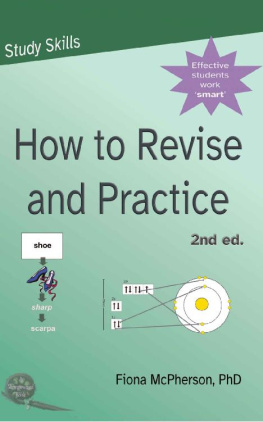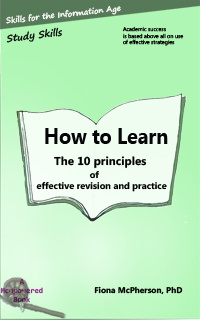Fiona McPherson - How to revise and practice
Here you can read online Fiona McPherson - How to revise and practice full text of the book (entire story) in english for free. Download pdf and epub, get meaning, cover and reviews about this ebook. year: 2020, publisher: Wayz Press, genre: Religion. Description of the work, (preface) as well as reviews are available. Best literature library LitArk.com created for fans of good reading and offers a wide selection of genres:
Romance novel
Science fiction
Adventure
Detective
Science
History
Home and family
Prose
Art
Politics
Computer
Non-fiction
Religion
Business
Children
Humor
Choose a favorite category and find really read worthwhile books. Enjoy immersion in the world of imagination, feel the emotions of the characters or learn something new for yourself, make an fascinating discovery.
- Book:How to revise and practice
- Author:
- Publisher:Wayz Press
- Genre:
- Year:2020
- Rating:3 / 5
- Favourites:Add to favourites
- Your mark:
- 60
- 1
- 2
- 3
- 4
- 5
How to revise and practice: summary, description and annotation
We offer to read an annotation, description, summary or preface (depends on what the author of the book "How to revise and practice" wrote himself). If you haven't found the necessary information about the book — write in the comments, we will try to find it.
How to revise and practice — read online for free the complete book (whole text) full work
Below is the text of the book, divided by pages. System saving the place of the last page read, allows you to conveniently read the book "How to revise and practice" online for free, without having to search again every time where you left off. Put a bookmark, and you can go to the page where you finished reading at any time.
Font size:
Interval:
Bookmark:
Published 2020 by Wayz Press, Wellington, New Zealand.
Copyright 2020 by Fiona McPherson.
All rights reserved.
First edition published 2013 as How to Learn: The 10 principles of effective revision and practice
No part of this publication may be reproduced, stored in a retrieval system, or transmitted in any form or by any means, electronic, mechanical, recording or otherwise, without the prior written permission of Wayz Press, a subsidiary of Capital Research Limited.
ISBN 978-1-927166-64-2
To report errors, please email errata@wayz.co.nz
For additional resources andup-to-date information about any errors, go to the Mempowered website at www.mempowered.com
Indo-European Cognate Dictionary
Beginning Ancient Greek: A Visual Workbook
Easy Russian Alphabet: A Visual Workbook
Effective Notetaking (3rd ed.)
Mnemonics for Study (2nd ed.)
Mnemonics for Study with Spanish glossary
Mnemonics for Study with Italian glossary
How to learn: The 10 principles of effective revision and practice
Successful Learning Simplified: A Visual Guide
How to Approach Learning: What teachers and students should know about succeeding in school
My Memory Journal
Planning to Remember: How toremember what youre doing and what you plan to do
Perfect Memory Training
The Memory Key
This workbook is a revised edition of my book How to learn: The 10 principles of effective revision and practice. That book was quite research-heavy, describing the experimental studies behind the principles I lay out. This revised edition has relegated such details to an appendix, and expanded greatly the section on practical applications. Some chapters remain essentially the same (the first two chapters, the short review chapter 7, the final chapter), with the addition of review questions and exercises. Other chapters (3, 4, 5, 6) have been heavily cut and edited, although there is still mention of various research studies, when the descriptions provide useful examples of tasks and strategies, as well as strengthening confidence in the recommended strategies. Chapters 8-14 are expanded versions of chapters 8 and 9, with lots of exercises. All chapters (with the exception of Chapter 7) have review questions. There are a number of exercises.
Note that numbers in square brackets, like this [3.1], refer to an entry in the Chapter Notes, which will expand on the research referred to for those interested in more details. If there is no further discussion of the research, there will simply be a normal study citation (e.g., Kornell 2019). The full reference can then be found in the References, at the end of the book. My apologies if doing these citations (rather than inserting a number) makes the text appear a little too academic for some readers, but I feel it makes it much easier to read if you know without checking the Chapter Notes whether I indeed have more to say on the subject, or am simply citing the source research.
To understand how to practice or revise effectively, you need to understand some basic principles about how memory works. This chapter covers:
- the 8 basic principles of memory
- how neurons work
- what working memory is and why its so important
- what consolidation is and why it matters
Practice (a term I use to cover both revision of information and the practice of skills) is a deceptively simple concept. Everyone thinks they know what it means, and what they think it is, basically, is repetition. When we have to remember an unknown phone number long enough to dial it, we repeat it to ourselves. As children told to learn a poem, we repeated it until we had it memorized. Learning to drive, we repeated the necessary actions over and over again. Repetition is at the heart of learning.
But simple repetition is the least effective learning strategy there is.
How do we reconcile these statements? Well, repetition is crucial to cement a memory, but the untutored way of doing it wastes a great deal of time, and still results in learning that is less durable than more efficient strategies.
In this book, Im going to tell you the 10 principles of effective repetition, why they work, and how they work. Well look at examples from science, mathematics, history, foreign language learning, and skill learning. At the end of it, youll know how to apply these principles in your study and your daily life.
Lets start with a very brief look at how memory works.
The most fundamental thing you need to understand about memory is that it is not a recording. When we put information into our memory, we dont somehow copy the real-world event, as a video camera might, but rather we select and edit the information. For this reason, putting information into memory is called encoding. This is why I habitually talk about memory codes rather than memories. Its a reminder that nothing in your memory is a pure rendition, a faithful copy. We create our memory codes, and when we try and retrieve a memory, it is this coded information that we are looking for. (Like a computer, what our brain processes is information when I use the word information, I dont just mean facts, but images and skills and events and everything else we file in long-term memory.)
Why does it matter that the information is coded?
Because what you think you are looking for may not be precisely what is there. How easy it is to remember something (retrieve a memory code) depends on the extent to which the code matches what you think youre looking for.
For example, say you are trying to remember someones name. You might think it begins with T, or that its unusual, or very common, or sounds something like -immy, or that its old-fashioned, or ... Whatever your idea is, the point is that there is an idea, a starting point, a clue (we call it aretrieval cue). How likely you are to retrieve the memory code depends on how good a clue it is.
This is because memory codes are linked together in a network. Remembering is about following a trail through the network, following the links. No surprise then that your starting point (the retrieval cue) is crucial.
For example, consider this simplified memory code for Henry VIII:

The size of the words reflect how strong those parts of the code are Anne Boleyn, for example, is for most of us the most memorable of Henrys wives; Elizabeth the most memorable of his children.
Accordingly, it would be a lot easier to retrieve Henry VIII if the retrieval cue was father of Elizabeth I than if it was father of Edward VI, or if the cue was established the Church of England rather than Cranmers king, or, worst of all, 16th century musician. (Do note that information in a memory code is not necessarily true! For example, Henry VIII did not actually write the song
Font size:
Interval:
Bookmark:
Similar books «How to revise and practice»
Look at similar books to How to revise and practice. We have selected literature similar in name and meaning in the hope of providing readers with more options to find new, interesting, not yet read works.
Discussion, reviews of the book How to revise and practice and just readers' own opinions. Leave your comments, write what you think about the work, its meaning or the main characters. Specify what exactly you liked and what you didn't like, and why you think so.











